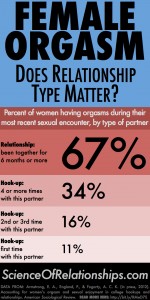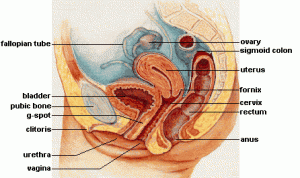In the majority of surveys, starting with the work by Shere Hite in 1976, one finding occurs consistently: few women reach orgasm during intercourse. The majority of women require stimulation of the clitoris before they reach orgasm.
So what can you do if you’re trying to pleasure a woman by bringing her to orgasm?
The difficulty or ease with which a woman reaches orgasm is clearly affected by a range of factors: genetic, social, emotional, and so on. For example, how much a woman trusts her man will affect how easily he can make her come during sexual interaction.
 One issue is simply that there are so many factors that impact on a woman’s ability to achieve orgasm. The same is true, of course, on a man’s ability to give a woman sexual pleasure in bed by making her come or bringing her to orgasm. These include some less obvious factors – for example, sociological issues such as the meaning and acceptability of orgasm in her culture and her social environment.
One issue is simply that there are so many factors that impact on a woman’s ability to achieve orgasm. The same is true, of course, on a man’s ability to give a woman sexual pleasure in bed by making her come or bringing her to orgasm. These include some less obvious factors – for example, sociological issues such as the meaning and acceptability of orgasm in her culture and her social environment.
 Also, some women feel more comfortable reaching orgasm during vaginal intercourse than through masturbation. They may have an association in their minds between clitoral stimulation or masturbation and socially unacceptable or otherwise negative behavior.
Also, some women feel more comfortable reaching orgasm during vaginal intercourse than through masturbation. They may have an association in their minds between clitoral stimulation or masturbation and socially unacceptable or otherwise negative behavior.
Equally, any sexual activity which might threaten the intimacy of a sexual relationship could be potentially threatening for some women. It may be less culturally threatening, too, for some women, if the man takes responsibility for his woman’s orgasm. And this means some men may be culturally pressured to know how to make a woman come. So we can see that both personality factors and the influence of culture and religion can be very important in the achievement of female sexual pleasure through orgasm.
Valuing a man who knows how to make a woman come!
In a survey of heterosexual women, John Bancroft asked how important various factors were in reaching orgasm and enjoying sexual happiness. In order of importance, the percentage of women answering “very” or “extremely” important to the following questions were:
1) to feel emotionally close to your partner – 83.5%
2) to feel your partner is sexually satisfied – 78.9%
3) to feel talking comfortable but your partner about – 61.5%
4) to have an orgasm – 29.6%
 This clearly indicates that intercourse and orgasm have a different significance to women than they do to men.
This clearly indicates that intercourse and orgasm have a different significance to women than they do to men.
Frequency of orgasm
Kinsey showed that, when asked about intercourse in general, 22% of women said they never experience orgasm. By contrast, this number dropped to 14% for “assisted” intercourse (i.e., when clitoral stimulation was specifically included). Among men who are sexually active, 72% claim that they always had an orgasm to climax and ejaculated during intercourse with a partner, 22% said they usually did, 4% said they sometimes did, and 2% said they rarely or never did.
 However, the implication that most women require clitoral stimulation to reach orgasm (which is really a simple factual observation) has caused controversy. Some sexologists believe that a man can only bring a woman to orgasmic pleasure through intercourse alone if her G spot has been awakened. This happens through a combination of sexual experience, sexual confidence, and emotional connection to her partner.
However, the implication that most women require clitoral stimulation to reach orgasm (which is really a simple factual observation) has caused controversy. Some sexologists believe that a man can only bring a woman to orgasmic pleasure through intercourse alone if her G spot has been awakened. This happens through a combination of sexual experience, sexual confidence, and emotional connection to her partner.
Certainly there is an abundance of circumstantial evidence around sexual orgasm in women. There seems to be a fundamental difference in origin and experience between sexual climax that’s achieved by clitoral stimulation compared to one achieved by stimulation of the vagina alone.
Whatever the truth, exploring such issues can be a good motivation for men and women to enjoy sexual interactions and mutual pleasure…. and certainly female orgasm is a good motivation for a man to learn how to really pleasure his partner in the way she would like. Men love to give women pleasure – it is a very affirming experience for them.
Ways to make a woman come
According to Cosmopolitan magazine, around 10% of women have never had an orgasm with a partner.
 And that is truly shocking! Considering that the basis of 99% of heterosexual relationships is love and sex, what can be done about it? Well, obviously, one of the things that can be done about it is for men to learn some great sexual techniques to increase a woman’s sexual pleasure.
And that is truly shocking! Considering that the basis of 99% of heterosexual relationships is love and sex, what can be done about it? Well, obviously, one of the things that can be done about it is for men to learn some great sexual techniques to increase a woman’s sexual pleasure.
So here, courtesy of Cosmo, are some useful tips for women to achieve orgasm during intercourse. (The text is addressed mainly to women!)
First of all, if you want to come easily, get on top during sexual intercourse. That way, if you lean forward, you can compress your clitoris between your pelvic bone and your man’s, providing clitoral stimulation – hopefully sufficiently intense to make you come. But the exact angle you’re going to use to achieve climax quickly will depend on how your bodies come together — for example, how big your bellies are.
 If the man is lying on the bed, it might be necessary for him to arch his back a little bit so that his pelvis is raised. This gives you the opportunity to “grind” your clitoris against his pelvis. Hopefully that will make you come.
If the man is lying on the bed, it might be necessary for him to arch his back a little bit so that his pelvis is raised. This gives you the opportunity to “grind” your clitoris against his pelvis. Hopefully that will make you come.
Now, one of the most important things to remember is that sex isn’t just about finding the right sexual position or technique. The truth of the matter is that women can become far more aroused than men during sex, and although it takes a different set of skills to arouse a woman to the point where she’s going to come than it does to arouse a man to that point. The interesting thing is that a man’s arousal depends to a large extent on how aroused his partner is.
Some women feel they have to fake orgasm to please their man. Instead, show your partner exactly what you need him to do to make you orgasm. You can say something like “I want to try something new and see if it makes reaching orgasm easier for me.” He’ll understand that! Or you could invite him to masturbate you, showing him exactly where to put his hand or tongue, to make your orgasm easy.
If you’re a woman who doesn’t come during intercourse — and very few women do — then explain to your partner that you like clitoral stimulation. Tell him you want more of this, especially during sex with him, so that you get even more pleasure in bed.
One of the ways that you can introduce the subject tactfully without hurting his feelings is by suggesting you enjoy some mutual masturbation to get you both aroused.
A general tip: you’ve no doubt heard of Kegel exercises? Believe me, Kegel exercises are one of the things that will make reaching orgasm a heck of a lot easier! You do need resistance, though, it’s no use just contracting the muscle as if you were stopping yourself urinating. That means buying something like the Kegel Master, a device specially designed for women to increase the strength of their PC muscles and hopefully make achieving orgasm easier for them.
However – there are other approaches that depend on slight changes in sexual position to give you much greater pleasure.In the classic missionary position, you can tilt your hips so that you’re directing his penis to the right spot inside your vagina. That “right spot” is the one most likely to make you come!
Alternatively, if he’s keen on giving you sexual pleasure in bed, you can grab hold of his hips and move him in exactly the way you need so that his erection stimulates your clitoris or vulva.
Pleasure in bed comes in many ways
So, during sex, it’s always possible for you, or him, to “lend a helping hand. ” In other words, for you or him to stimulate your clitoris, thereby helping yourself reach orgasm easily. Similarly, if you’re actually lying face down in the rather nice and comfy position that is called “reverse missionary”, then one option is view to grind your clitoris against a pillow or the bed itself.
Female ejaculation during orgasm
Some women are worried by a tendency to release fluid during orgasm, often assuming that the fluid is urine. However, analysis of the fluid suggests that it contains chemical compounds which are reminiscent of prostate secretions in men.
Women who ejaculate during intercourse develop a swelling in the anterior vaginal wall close to the area of the G spot which disappears when ejaculations taken place.
This swelling seems to be caused by the fluid collecting in the urethra at that point, before it is expelled from the body during sexual arousal.
Here’s ex educator Laci Green on “Squirting”
Although there is considerable variability between different women in the degree to which they have paraurethral ducts around the urethra, it may well be that the fluid secreted by these ducts and the associated glands is the one that can be expelled during “female ejaculation”.
This is a process that appears to be similar to the ejection of semen from the body after the emission phase of sexual response (when semen is released into the urethra before expulsion) in men.
The function of a woman’s orgasm
Although one obvious function of male orgasm might be to encourage mating, with the consequent ejaculation of semen, it’s not quite so clear what the function of orgasm in women might be.
Suggestions include the simple emotional reward of pleasure “for” allowing sexual intercourse to take place, the resolution of vaginal tenting (ballooning of the vagina during orgasm) which allows the cervix to dip down into the pool of semen left in the vagina after ejaculation.
And also, it seems, stimulation of the man’s penis so that he ejaculates because of the stimulation of the vaginal contractions on his glans and penile shaft. Other ideas include the reinforcement of pair bonding, and the upsuck of semen into the uterus.
The problem with these explanations is that very few women experience orgasm as a result of sexual intercourse alone. This makes it difficult to explain how female orgasm came to evolve if it was a reward for allowing intercourse to occur!
But in the end does it matter? We know what orgasm feels like, and we know it bonds a couple closely. Maybe all we need to know is that it is wonderful to know how to make a woman come and to give and receive sexual pleasure in bed!